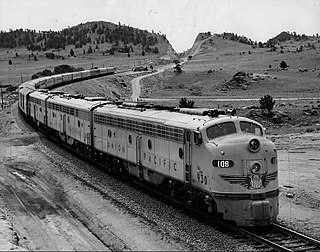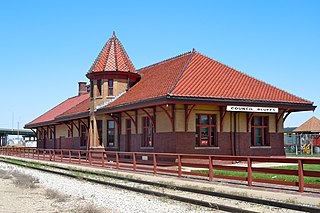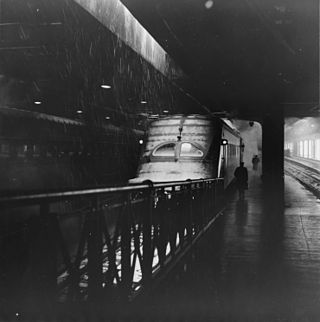
The Chicago, Milwaukee, St. Paul and Pacific Railroad (ACMStP&P), better known as the Milwaukee Road, was a Class I railroad that operated in the Midwest and Northwest of the United States from 1847 until 1986.

The City of Denver was a streamlined passenger train operated by the Union Pacific Railroad between Chicago, Illinois, and Denver, Colorado. It operated between 1936 and 1971. From 1936–1955 the Chicago and North Western Railway handled the train east of Omaha, Nebraska; the Chicago, Milwaukee, St. Paul and Pacific Railroad handled it thereafter. The train was the fastest long-distance train in the United States when it debuted in 1936, covering 1,048 miles (1,687 km) in 16 hours. For almost its entire career its principal competitor was the Chicago, Burlington and Quincy Railroad's Denver Zephyr. When Amtrak assumed operation of most intercity trains in the United States in 1971, it discontinued the City of Denver, preferring to use the Burlington's route between Chicago and Denver.

The Hiawathas were a fleet of named passenger trains operated by the Chicago, Milwaukee, St. Paul and Pacific Railroad between Chicago and various destinations in the Midwest and Western United States. The most notable of these trains was the original Twin Cities Hiawatha, which served the Twin Cities in Minnesota. The train was named for the epic poem The Song of Hiawatha by Henry Wadsworth Longfellow. The current Amtrak Hiawatha train is directly descended from the Milwaukee Road trains.

The Chicago and North Western was a Class I railroad in the Midwestern United States. It was also known as the "North Western". The railroad operated more than 5,000 miles (8,000 km) of track at the turn of the 20th century, and over 12,000 miles (19,000 km) of track in seven states before retrenchment in the late 1970s. Until 1972, when the employees purchased the company, it was named the Chicago and North Western Railway.

The 400 was a named passenger train operated by the Chicago and North Western Railway between Chicago and Saint Paul, with a final stop in Minneapolis. The train took its name from the schedule of 400 miles between the cities in 400 minutes, and was also a nod to "The Four Hundred Club", a term coined by Ward McAllister to refer to the social elite of New York City in the late 19th century. It was an express train with limited stops between Chicago and the Twin Cities. The "400" ran from 1935 to 1963 on the Chicago to Twin Cities route. The C&NW later named their other passenger trains using the number "400".

The Chicago, St. Paul, Minneapolis and Omaha Railway or Omaha Road was a railroad in the U.S. states of Nebraska, Iowa, Minnesota, Wisconsin and South Dakota. It was incorporated in 1880 as a consolidation of the Chicago, St. Paul and Minneapolis Railway and the North Wisconsin Railway. The Chicago and North Western Railway (C&NW) gained control in 1882. The C&NW leased the Omaha Road in 1957 and merged the company into itself in 1972. Portions of the C. St. P. M. and O. are part of the Union Pacific Railroad network. This includes main lines from Wyeville, Wisconsin, to St. Paul, Minnesota, and St. Paul to Sioux City, Iowa.

The Olympian and its successor the Olympian Hiawatha were passenger trains operated by the Chicago, Milwaukee, St. Paul and Pacific Railroad between Chicago and the Pacific Northwest. The Olympian operated from 1911 to 1947 and was, along with its running mate the Columbian, the first all-steel train to operate in the Pacific Northwest. The streamlined Olympian Hiawatha operated from 1947 to 1961 and was one of several Milwaukee Road trains to carry the name "Hiawatha". The Olympian Hiawatha was designed by industrial designer Brooks Stevens and included the distinctive glassed-in "Skytop" observation-sleeping cars. It later featured full-length "Super Dome" cars.
The Fremont and Elkhorn Valley Railroad was a 17-mile (27 km) heritage railroad headquartered in Dodge County, Nebraska, which offered excursion services on the line. Its equipment is now owned by the Nebraska Railroad Museum.

The Columbian was a named passenger train operated by the Chicago, Milwaukee, St. Paul and Pacific Railroad between Chicago, Illinois, and Seattle/Tacoma, Washington. The westbound train was Milwaukee Road train #17, and the eastbound train was train #18. It was launched on Monday, May 29, 1911. The same day, the faster, limited-stop and more luxurious Olympian also launched. These were the first passenger trains to take advantage of the Milwaukee Road Pacific Extension, which had opened to freight in 1909.

The Challengers were named passenger trains on the Union Pacific Railroad and the Chicago and North Western Railway. The economy service ran between Chicago, Illinois, and the West Coast of the United States. The trains had full Pullman service and coach seating and were an attempt to draw Depression-Era riders back to the rails. Food service was advertised as "three meals for under a dollar a day."
The Sioux was a named passenger train of the Milwaukee Road that operated between Chicago, Madison, Wisconsin, and Rapid City, South Dakota, via Prairie du Chien, Wisconsin and northern Iowa. The train, #11, westbound, and #22, eastbound, operated coaches, dining cars and sleeping cars through most of its history.

The Arrow was a passenger train operated by the Chicago, Milwaukee, St. Paul and Pacific Railroad between Chicago, Illinois and Omaha, Nebraska. It operated from 1926 until 1967. The Arrow provided overnight service between the two cities and included through cars for other destinations in Iowa.

The Twin Cities Hiawatha, often just Hiawatha, was a named passenger train operated by the Chicago, Milwaukee, St. Paul and Pacific Railroad, and traveled from Chicago to the Twin Cities. The original train takes its name from the epic poem The Song of Hiawatha by Henry Wadsworth Longfellow. There are a number of Hiawatha-themed names within the city of Minneapolis, the terminus of the original train. The first Hiawatha ran in 1935; in 1939 the Milwaukee Road introduced a second daily trip between Chicago and Minneapolis. The two trains were known as the Morning Hiawatha and Afternoon Hiawatha, or sometimes the AM Twin Cities Hiawatha and PM Twin Cities Hiawatha. The Milwaukee Road discontinued the Afternoon Hiawatha in 1970 while the Morning Hiawatha continued running until the formation of Amtrak in 1971.

RailsWest Railroad Museum is a railroad museum operated by the Historical Society of Pottawattamie County at 16th Avenue and South Main Street and illustrates the history of railroads in Council Bluffs, Iowa.

The North Woods Hiawatha was a streamlined passenger train operated by the Chicago, Milwaukee, St. Paul and Pacific Railroad between New Lisbon and Minocqua, Wisconsin. It operated from 1936 until 1956. The North Woods Hiawatha was the first new route to adopt the Hiawatha brand.

The Skytop Lounges were a fleet of streamlined passenger cars with parlor-lounge cars built by the Chicago, Milwaukee, St. Paul and Pacific Railroad and sleeper-lounges built by Pullman-Standard in 1948. The cars were designed by famed industrial designer Brooks Stevens. The fleet included both parlor-lounges and sleeping cars. The lounges entered service in 1948 on the Twin Cities Hiawatha, while the sleeping cars were used on the long-distance Olympian Hiawatha. In 1964 the Milwaukee Road sold the sleeping cars to the Canadian National Railway, which operated them until 1977. The parlor cars continued in service with the Milwaukee Road until 1970, when they were retired.
The Chippewa consisting of mostly conventional components, and later known as the Chippewa-Hiawatha, with a streamlined consist was a passenger train operated by the Chicago, Milwaukee, St. Paul and Pacific Railroad between Chicago, Illinois and Michigan's Upper Peninsula. It operated from 1937 to 1960. The Chippewa-Hiawatha was one of several regional trains to carry the "Hiawatha" brand.

The Varsity was a passenger train operated by the Chicago, Milwaukee, St. Paul & Pacific Railroad over a 140-mile route between Chicago and Madison, Wisconsin.

The D&I Railroad (DAIR) is a Class III shortline railroad which is a wholly owned subsidiary of L. G. Everist, Inc. The line hauls ethanol, dried distillers grains (DDG), corn oil, plastic pellets, cement, sand, gravel, and Sioux Quartzite, which is mined from two large quarries in Dell Rapids.

Marion station was a railroad station in Marion, Iowa. It served passenger trains of the Chicago, Milwaukee, St. Paul and Pacific Railroad, commonly known as the Milwaukee Road. After passenger train service was discontinued, elements of the station were moved across the street to City Square Park, where it remains as a pavilion today. The structure is listed as a non-contributing property by the National Register of Historic Places in the Marion Commercial Historic District.



















